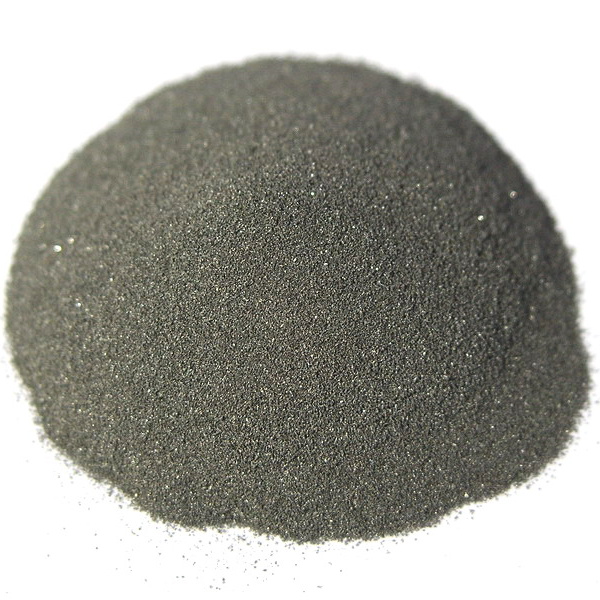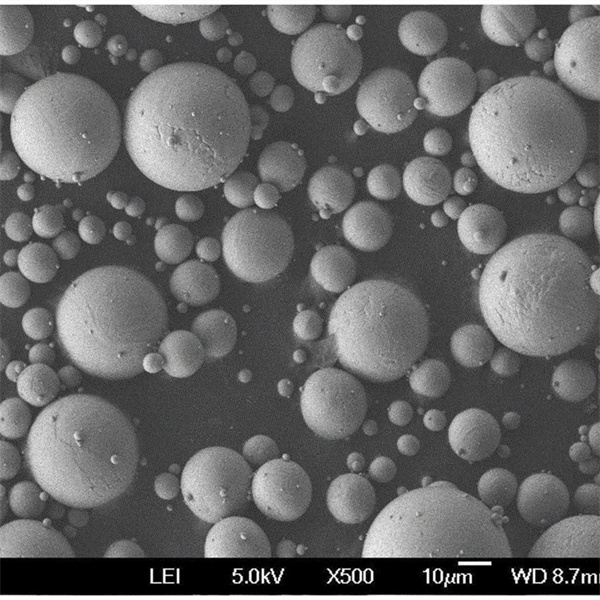몰리브덴 금속 분말 개요
몰리브덴 분말은 몰리브덴 금속에서 생산되는 내화성 금속 재료로, 녹는점이 매우 높고 고온에서 강하며 마모와 부식에 강한 것으로 알려져 있습니다. 이러한 주요 특성 덕분에 몰리브덴 분말은 항공우주, 방위, 자동차, 발전과 같은 산업 전반의 부품 및 복합재 제조에 이상적인 선택입니다.
표 1: 몰리브덴 분말 개요
| 속성 | 설명 |
|---|---|
| 구성 | >99% 순수 몰리브덴 |
| 주요 속성 | 높은 강도, 경도, 내열성/내식성, 윤활성 |
| 생산 방법 | 가스 분무, 전기 분해, 카보닐 공정 |
| 입자 크기 | 1 - 100 미크론 |
| 주요 애플리케이션 | 합금제, 용사 분말, 3D 프린팅 |
2623°C로 순수 금속 중 두 번째로 높은 녹는점과 2000°C 이상에서도 강도가 유지되는 몰리브덴은 까다로운 환경에서 고유한 이점을 제공합니다. 고온에서도 뛰어난 내식성과 윤활성을 갖춘 몰리 분말은 산업 전반의 분말 야금 응용 분야에 탁월한 성능을 제공합니다.

몰리브덴 분말의 종류
몰리브덴 분말 은 가스 분무, 전해 또는 카보닐 분해 공정을 사용하여 다양한 형태로 상업적으로 생산됩니다. 이러한 생산 기술은 주요 응용 분야에 맞게 다양한 입자 크기 분포, 모양 및 순도 수준을 제공합니다.
표 2: 몰리브덴 분말의 주요 유형
| 유형 | 설명 | 일반적인 용도 |
|---|---|---|
| 가스 분무 | 5-100 미크론의 구형 분말 | 용사, MIM 합금 |
| 전해질 | 1~10미크론의 불규칙한 플레이크 | 소결 부품, 전자 제품 |
| 카보닐 | 1미크론 미만의 구형, 최고 순도 | 화학/야금 애플리케이션 |
가스 분무 형태 조절이 가능하고 입자 분포가 촘촘한 분말은 프레스, 적층 제조, 열분사 및 합금에 적합하기 때문에 가장 널리 채택되는 유형입니다.
한편, 초미세먼지는 카보닐 몰리 분말 분해를 통해 생산된 제품은 야금 첨가제나 촉매와 같이 높은 화학적 순도를 필요로 하는 틈새 응용 분야에 사용됩니다. 높은 표면적은 소결 응용 분야에도 적합하지만 비용 때문에 채택이 제한됩니다.
응용 분야 요구 사항을 이해하면 최적의 성능을 위한 적절한 몰리브덴 분말 사양을 쉽게 찾을 수 있습니다.
몰리브덴 금속 분말의 특성
몰리브덴 분말 는 기계적, 열적, 전기적, 화학적 특성의 탁월한 조합으로 까다로운 운영 환경에서도 성능을 향상시킵니다.
표 3: 몰리브덴 분말 속성 개요
| 속성 | 가치 | 중요성 |
|---|---|---|
| 녹는점 | 2623°C | 고온에서도 강도와 경도 유지 |
| 밀도 | 10.22g/cc | 무거운 합금 배합 가능 |
| 힘 | 500MPa(73ksi) | 높은 기계적 부하를 견딤 |
| 열 전도성 | 138W/mK | 열 확산 능력 |
| 전기 저항 | 5.7 마이크로옴-cm | 전자 열 관리 |
| 마찰 계수 | 0.1-0.3 | 진공 환경에서도 윤활성 유지 |
고온 강도, 내식성, 낮은 마찰, 열/전기 전도성과 같은 주요 특성은 잠재적으로 혁신적인 분말 야금 응용 분야에서 중요한 성능 요구 사항을 충족합니다.
또한 몰리브덴은 100% 재활용성과 결합된 높은 밀도로 인해 경쟁 희토류 원소에 비해 환경 친화적이고 지속 가능한 금속으로 선택됩니다. 이는 배터리, 자석, 의료 기기, 항공우주 부품 및 기타 제품의 코발트나 텅스텐과 같은 원소를 파괴할 수 있습니다.
소결 중에 강도, 융점, 밀도, 저항률, 경도와 같은 특성이 어떻게 변화하는지 이해하면 최적의 서비스 동작을 위한 적절한 분말 사양과 공정 파라미터를 쉽게 찾을 수 있습니다.
생산 방법 몰리브덴 분말
상업용 몰리브덴 분말은 고객이 원하는 입자 크기, 형태, 순도 수준, 결정 구조 및 분말 특성을 달성하기 위해 세 가지 주요 생산 경로를 활용합니다.
표 4: 몰리브덴 분말 생산 경로 비교
| 방법 | 설명 | 일반적인 순도 | 비용 요소 |
|---|---|---|---|
| 가스 분무 | 불활성 가스가 용융 스트림을 분해합니다. | >99% Mo | 가격은 몰리 가격을 따르고, 순도가 높을수록 프리미엄이 붙습니다. |
| 전기 분해 | 분말 플레이크에 양극 용해 | 99.8%+ Mo | 높은 전력 소비, 낮은 재료 수율 |
| 카보닐 공정 | 열 분해하여 벌금 | 99.99%+ Mo | 엄격하게 통제되는 프로세스, 제한된 수의 생산자 |
가스 분무 는 가장 광범위한 파우더 크기와 형태를 제공하므로 상업 및 연구 분야에서 가장 널리 채택된 파우더 유형입니다.
한편 카보닐 프로세스 오염이 위험을 초래할 수 있는 특수 화학 공정 애플리케이션에 필요한 극도의 순도를 생성합니다.
적절한 생산 방법을 선택하려면 비용, 입자 특성, 순도 요구 사항, 가용성 등의 요소를 균형 있게 고려해야 합니다.
몰리브덴 분말 제품 사양
몰리브덴 분말은 조성, 입자 크기 분포, 형태, 순도 수준, 결정 구조 및 미세 구조와 관련된 엄격한 특성 사양을 충족해야 합니다. 제조업체는 고급 품질 관리 도구를 사용하여 분말의 적합성을 검증합니다.
표 5: 일반적인 몰리브덴 분말 사양
| 매개변수 | 일반 사양 | 테스트 방법 |
|---|---|---|
| 입자 크기 분포 | 고객 요청에 따라(1~100미크론) | 레이저 회절 입자 분석기 |
| 화학 | >99% 몰리브덴 | ICP 질량 분석 |
| 산소/질소 | < 500ppm 미만 | 불활성 기체 융합 분석 |
| 형태학 | 구형 | SEM 이미징 |
| 순도 | 99.9% ~ 99.9999% | GDMS 미량 원소 분석 |
| 겉보기/탭 밀도 | 이론상 35~50% / 65~80% | 홀 유량계 깔때기 |
| 결정 구조 | BCC | X-선 회절 |
유량, 겉보기 및 탭 밀도, 산소/질소 수준, 미세 구조 단계와 같은 파우더 특성을 제어하면 최적의 파우더 확산, 압축, 소결 및 최종 부품 성능을 보장할 수 있습니다.
몰리브덴 생산업체는 다음과 같은 절차를 통해 품질 보증 노력을 지속적으로 강화합니다:
- 중요 파라미터의 통계적 프로세스 제어 모니터링
- 샘플링 속도 및 테스트 주파수에 대한 데이터 분석
- 오염 방지를 위한 직원 교육
- ISO 9001:2015, AS9100D, ISO 13485와 같은 표준에 대한 인증
이를 통해 의료, 항공우주, 방위 및 산업 시장 부문에서 제품 일관성, 추적성 및 고객 사양 준수를 지속적으로 개선할 수 있습니다.
몰리브덴 분말의 등급 및 표준
항공우주, 석유 및 가스, 방위, 발전 등의 분야에서 널리 사용되는 엔지니어링 소재인 몰리브덴 분말 제품은 다양한 순도 등급과 국내/국제 표준을 충족해야 합니다.
표 6: 몰리브덴 금속 분말의 일반적인 등급 및 표준
| 표준 | 설명 | 필수 속성 |
|---|---|---|
| ASTM B939 | 전해질 몰리 파우더 사양을 다룹니다. | >99.8% Mo, 산소 한계, 입자 크기 분포 |
| SAE AMS 7871 | 기체 분무 분말용 항공우주 재료 사양 | 화학, 입자 크기 분포, 겉보기 밀도 |
| ISO 21109 | 플라즈마 스프레이 등급 분말에 대한 요구 사항 설정 | 입자 크기 분포, 유량 |
| 사용자 지정 성적 | 애플리케이션별 파우더 변형 | 개별 고객 요구 사항에 따라 |
또한 ASTM International과 같은 국가 기관과 전문 무역 그룹은 산업 전반에 걸쳐 몰리브덴 분말의 응용 분야가 계속 발전함에 따라 재료 사양 및 시험 방법에 대한 지속적인 개발을 지원합니다.
재료 제조업체, 적층 제조 및 적층 가공 부품 제조업체, 최종 사용 고객 간의 연구 협력을 통해 합금 첨가, 입자 크기 범위 또는 오염 물질 제한과 같은 요소를 중심으로 최적화된 맞춤형 파우더 등급을 검증할 수도 있습니다.
몰리브덴 금속 분말의 응용 분야
극한 온도 강도, 내마모성/내식성, 열 전도성, 윤활성 및 환경 안정성의 탁월한 균형 덕분에 가능합니다, 몰리브덴 분말 다양한 산업 분야에서 획기적인 성능 향상을 지원합니다.
표 7: 몰리브덴 분말의 주요 응용 분야
| 애플리케이션 | 설명 | 혜택과 대안 |
|---|---|---|
| 합금 에이전트 | 강철 및 초합금에 추가 | 고온에서의 강도 및 경도 |
| 용사 코팅 | 부식/침식에 대한 내마모성 필름 | 크롬 카바이드 대체품보다 우수한 경도 및 윤활성 |
| 소결 PM 부품 | 구성 요소의 그물 모양 제작 | 텅스텐 대비 1800°C 이상의 고강도 |
| 전자 제품 | 디바이스/프로세스의 열 관리 | 알루미늄 대체재의 이중 전도성 |
| 원자로 | 극한 온도 부품 | 크롬/탄탈륨 옵션보다 구조적 안정성 유지 |
연구 개발 노력의 확대는 다음과 같은 분야에서 몰리브덴 금속 분말의 새로운 가능성을 여는 데 초점을 맞추고 있습니다:
석유 및 가스 탐사
- 부식/마모에 강한 다운홀 공구 및 드릴링 장비
- 고압 펌프용 밸브 및 씰
자동차/항공우주
- 극한의 온도를 다루는 피스톤, 엔진 및 배기 부품
- 고밀도 합금에 대한 경량화 기회
의료
- 생체 적합성과 고강도를 활용한 임플란트
- 반복 멸균을 견디는 수술 도구
3D 프린팅
- 몰리 파우더 맞춤 특성을 이용한 맞춤형 합금 배합
- 내화성 금속 지지 구조물
몰리브덴의 독특한 열적, 기계적, 전기적, 환경적 안정성으로 인해 이 지속 가능한 소재는 향후 10년 동안 분말 야금 기술 전반에 걸친 혁신의 주요 후보가 될 것입니다.
몰리브덴 금속 분말의 인기 공급 업체
많은 주요 금속 분말 생산업체들이 틈새 연구 분야부터 대량 상업 분야까지 다양한 수요를 충족하는 몰리브덴 분말 조성물을 제공합니다. 주요 다중 금속 공급업체와 전문 몰리브덴 가공업체 모두 이 시장에서 활발히 활동하고 있습니다.
표 8: 주요 몰리브덴 분말 제조업체
| 회사 | 설명 | 프로덕션 기능 |
|---|---|---|
| H.C. 스탁 솔루션 | 맞춤형 합금을 포함한 광범위한 Mo 파우더 포트폴리오 | 연간 수백 톤 규모의 모든 주요 생산 경로 |
| Molymet | 최고의 몰리브덴 화학 및 분말 가공기 | 금속을 넘어선 고순도 몰리 산화물, 탄화물, 질화물 |
| JDC | 분무 및 전해 기능을 갖춘 일본 분말 리더 | 다양한 스테인리스, 몰리브덴 합금강 제품군 |
| Plansee | 내화성 금속 분말 전문성 | Mo, W, Ta 시스템을 중심으로 한 맞춤형 합금 개발 |
| 미테크 텅스텐 금속 | 텅스텐 및 몰리 분말의 미국 주요 생산업체 | 전해질 몰리 플레이크, 산화물, 기타 화합물 |
이 업계 리더들은 향후 5년간 의료, 항공우주, 자동차 및 산업 분야에서 몰리브덴 분말의 채택이 가속화됨에 따라 최신 응용 분야 수요를 충족하기 위해 생산 능력, 품질 개선 및 새로운 조성 개발에 지속적으로 투자하고 있습니다.
몰리브덴 분말의 비용 분석
특수한 마이너 금속인 몰리브덴 분말 가격은 수요와 공급을 둘러싼 시장 역학 관계에 따라 변동합니다. 그러나 몰리 파우더는 텅스텐이나 탄탈륨과 같은 경쟁 내화 금속에 비해 상당한 비용 우위를 유지하고 있습니다.
표 9: 몰리브덴 분말 비용 분석
| 매개변수 | 일반적인 범위 | 드라이버 |
|---|---|---|
| 몰리브덴 금속 가격 | $25-40 kg당 | 원시 광물 공급/수요 변동 |
| 몰리브덴 분말 | kg당 $50-150 | 순도 등급, 생산 경로, 유통 채널 |
| 텅스텐 분말 | $50-250 kg당 | 중국보다 낮은 생산량, 제한된 공급업체 |
| 탄탈륨 분말 | $400-1000 kg당 | 매우 희귀한 미네랄 공급 |
예를 들어 순도 99.9%의 몰리브덴 분말은 가스 분무 방식을 사용하여 대량으로 판매할 경우 kg당 약 $60에 판매됩니다. 반면 순도 99.99%의 초저산소 변형은 kg당 $140으로 2배 이상 프리미엄이 붙습니다.
텅스텐과 탄탈륨 분말에 비해 몰리브덴은 광물 매장량이 많고 채굴 생산량이 높아 상당한 비용 이점을 유지합니다. 이를 통해 몰리브덴 분말 솔루션은 자동차, 항공우주, 산업용 난방, 심지어 의료용 임플란트 범주에서 경쟁 내화성 금속을 대체할 수 있습니다.
향후 10년 동안 몰리 파우더의 극한 온도 특성, 제조의 다양성, 경제성 등 독특한 균형으로 인한 시장 채택 증가로 인해 대규모 생산 능력 확장을 제외하면 공급 부족이 예상됩니다. 이는 수요 증가가 채굴 생산량 증가를 앞지르면서 현재의 주기적인 원자재 침체기를 넘어서는 가격 상승을 시사할 가능성이 높습니다.
몰리브덴 분말 채택에 대한 향후 전망
몰리브덴의 탁월한 특성을 활용하는 데 초점을 맞춘 연구 및 상용화 노력이 확대되면서 운송, 에너지, 의료, 방위, 산업용 난방 부문에서 몰리 기반 분말 합금의 채택이 훨씬 더 광범위해질 것으로 예상됩니다.
시장 분석가들은 새로운 응용 분야가 기존 합금과 가공하기 어려운 재료를 대체함에 따라 향후 5년간 몰리브덴 금속 및 합금에 대한 전 세계 수요가 연평균 61% 이상 성장할 것으로 예측합니다. 특히 금속 사출 성형, 적층 제조, 몰리브덴 합금의 열분사 등 분말 야금 제조 방식은 밀링 제품 형태에 비해 평균 이상의 확장이 가능한 것으로 보입니다.
그러나 채굴 능력이 크게 증가하지 않는 한 에너지 및 산업 부문의 급속한 수요 확대와 맞물려 몰리브덴 원광의 지속 가능한 공급은 압박에 직면할 수 있습니다. 현재 주기적인 침체기를 겪고 있지만, 장기적인 펀더멘털은 상당한 신규 채굴 프로젝트가 없는 한 10년 중반까지 몰리 제품에 대한 가격 상승 압력이 다시 높아질 것으로 예상됩니다.

자주 묻는 질문
Q: 몰리브덴 분말과 가장 잘 혼합되는 합금 원소는 무엇인가요?
A: 니켈, 크롬, 실리콘, 붕소, 탄소, 코발트는 적용 목적에 따라 소결성, 강도, 경도 또는 고온 크리프 저항성을 향상시키기 위한 일반적인 합금 소재입니다.
Q: 몰리브덴 분말 소결에 가장 적합한 입자 크기 범위는 무엇입니까?
A: 5~25미크론의 가스 분무 몰리브덴 분말은 대부분의 제조 부품 응용 분야에서 최적의 압착 및 소결 거동을 보입니다.
Q: 몰리브덴 분말을 AM 방식으로 처리하는 것은 얼마나 어렵나요?
A: 컬링, 다공성 문제 또는 미세 균열과 같은 결함을 제어하려면 레이저/전자 빔 시스템에 대한 세심한 파라미터 개발이 필수적입니다. 열간 등방성 프레스는 밀도와 기계적 성능을 극대화하는 데 도움이 됩니다.
Q: 몰리브덴 분말에 고순도가 중요한 이유는 무엇인가요?
A: 산소, 질소, 탄소와 같은 오염 물질은 연성에서 취성 전이 온도를 크게 변화시켜 인쇄 또는 소결 중에 제작성을 떨어뜨리고 자연 균열을 유도합니다. 화학 물질을 더 엄격하게 제어하면 이러한 문제를 최소화할 수 있습니다.
Q: 몰리브덴 분말 제품에 부식 위험이 있는 응용 분야에는 어떤 것이 있습니까?
A: 바닷물, 산성 유황/염화물 화합물, 용융 아연은 몰리브덴을 공격합니다. 크롬, 니켈 또는 코발트의 작은 합금 첨가물은 내식성을 향상시킵니다. 보호 코팅은 또한 정기적인 유지보수를 통해 문제가 있는 환경에서의 우려를 완화합니다.






